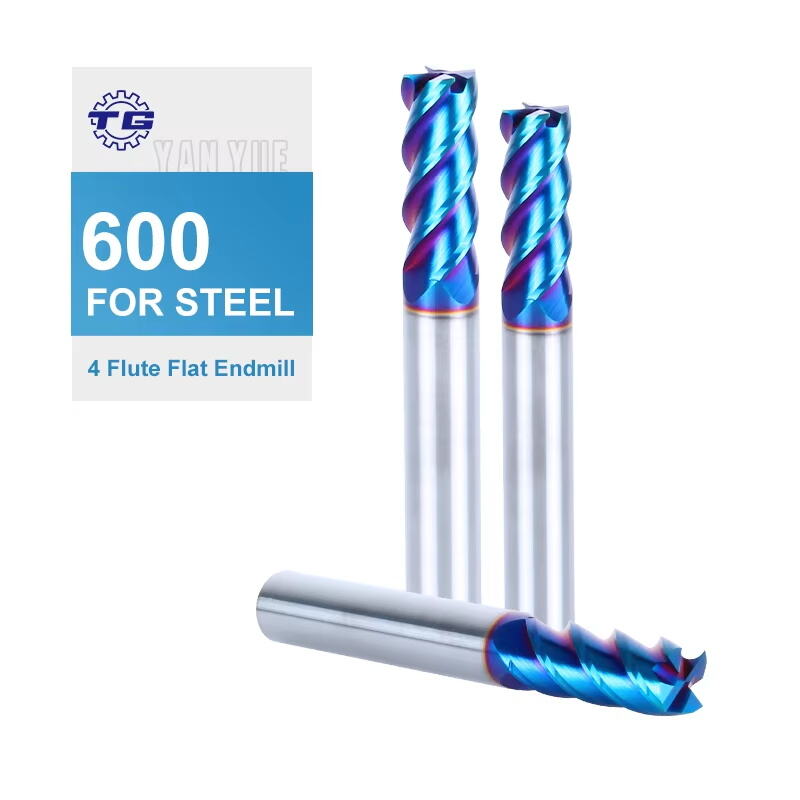היכרות עם מחטים קרביד
סקירה על מחטים קרביד
יוצר הארכיון: מקצות סיבי קרביד הן כלים שבהם חומר הקשה הוא קרביד טונגסטן, שהוא קשה וمقاומת לבלאי. הם מייצרים יישומים בטמפרטורות גבוהות ומשמרים את קצות החיתוך חדים למשך תקופות ארוכות. קיימות מספר סוגים של מקצות קרביד שניתן לבחור מהן צורות שונות, כגון מרובע, כדוריות, רדיוס פינה, ומקצצה גסה. שתיהן מותאמות למשימות מסוימות, לדוגמה עיצוב מפורט לעומת חיתוך מהיר. מקצות סיבי קרביד בעולם עיבוד ה-CNC יצרו סטנדרט חדש בחיתוך ובעיצוב והפכו לנכס בכל חליפת מכונות. התפוקה של מקצות סיבי קרביד מתבטאת במיוחד בתהליך החיתוך של תבניות. כלים מקרביד פועלים בקירור טוב יותר מאשר כלים מפליז מוצק במהירות, עם יתרון נוסף של מהירות גבוהה יותר, גימור משטח טוב יותר וחיי עבודה ארוכים הם יתרונות ברורים של קרבידים לעומת HSS בהנדסה מדויקת.
חשיבות חשיבות בעיבוד מודרני
בעולם העיבוד המודרני, דיוק ואיכות הם בעלי חשיבות עליונה, ולכן שימוש בקצוות תיבוד קרביד הוא כה נפוץ. פתרונות אלו יכולים להפחית משמעותית את עלויות הייצור וגם להוביל להצלחה קצרת טווח. בעזרת קצוות תיבוד קרביד, יצרנים יכולים לחתוך מהר יותר ובצריכת חשמל נמוכה יותר, תוך השגת גימור טוב יותר ובלי שבבים שיש לנקות, מה שэкономי באופן כולל, שכן אין צורך לנקות שבבים. חשוב לציין, מומחים בתחום התעשייה מודעים לכך שעליכם לשלב קצוות תיבוד קרביד אם ברצונכם להתחרות בסביבת הייצור של ימינו. הם טוענים כי על מנת להוביל את הדרך, השקעה בסוג זה של טכנולוגיות מתקדמות אינה אפשרות, אלא צעד חיוני כדי להגיב לצריכת הגדלה במרכיבים מותכתיים מתקדמים.
מטחני קצה מרובע: דיוק לפינות חדות
תכונות עיצוב ויכולות חיתוך
קצות המטחנה הריבועיים בעלי קצה שטוח עם פינות חדות, ומיוצרים לרוב למטרת ריבוע גושים או פיסות עבודה. הבנייה הזו מאפשרת להם לחתוך ישר דרך החומר ולצורת חורים מדויקים עם קצוות נקיים. בנוסף, קצות מטחנה ריבועיים מיוצרים בכמה גאומטריות ובקטיפים כדי לשפר את הביצועים ולהאריך את חיי הכלים. החומר קרביד חזק דיו כדי לחתוך בתוך כל סוגי החומרים, לרבות פלסטיק רך ומתכות קשות. בדיוק הwersatility של העיצוב הזה היא שמאפשרת לקצות מטחנה ריבועיים לשמש במגוון תהליכים.
יישומים בחיתוך סלטים ובצורת חיתוך
בapplications מסוימות, מקדחות סמוכות הן מتفוצות בשל הדיוק שלהן, במיוחד חציבה ופּחֵית. הם משמשים בצורה נרחבת בapplications כמו תעשיית הרכב ותעופה וفضה שבהן הרכיבים שמייצרים דורשים סובלנות של עד מספר מיקרומטרים, אם לא פחות. לדוגמה, כשסוג הסлот נדרש למכונת חקיקה עם קצוות מדויקים, או חומר גלם מופעל שמכיל תחתית שטוחה מדויקת, משתמשים במקדחות סמוכות. ישנן מספר דוגמאות מוכחות במחקרים điểnתיים. לדוגמה, חברה המתמקדת בתעופה וفضה חקקה כמות גדולה של חלקים מורכבים מאוד של שלדPeshtemal בעזרת מקדחות סמוכות.
יתרונות לדיווק תעשייתי
הם נפוצים בשימושים כגון הנדסת מכונות ומכאניקה, בתעשייה הפטרוכימית, האוטומotive ואווירית-חללית. השימוש בהם מפחית משמעותית את עבודת השחזור והפסולת, ובכך מפחית את עלות הייצור. מעבידים רבים גילו כי השימוש בקצות מרובעים יכול להפחית את אחוזי השחזור ב-30%. מומחים מדגישים את היתרונות שבבחירת הכלי הנכון למשימה; קצות מרובעים מספקים מוצר מהימן שאינו מאכזב. מגוון הכלי הזה הוא חיוני כשמבקשים דיוק תעשייתי בתנאי עיבוד מגוונים.
מברשות עם קצה כדור: שליטה בשטחים עקומים
תלת מימדיים וצורות מורכבות
לסיכום, השימוש בקצות חריצה עם ראש כדורית הוא חיוני לעוצרי תכנון המעוניינים לשלוט בעיצוב קמור תלת-ממדי. הראש הכדורי בנוי במיוחד לנוע לאורך כל הצורות תלת-הממדיות המורכבות עם חיכוך מזערי. זהו האפשרי הטוב ביותר למשטחים הדורשים עיבוד חלק ודetailed. בנוסף לאפשרות הסרת הפסולת בצורה יעילה, קצות החריצה הכדוריים הביאו לשיפור באיכות הסיום השטוחי תוך כדי עיבוד משטחים מעוקלים. לאורך השנים, חדשנות טכנולוגית הובילה לייצור מתקדם יותר של קצות חריצה כדוריים. החדשנות הביאה לשיפור במדויקות הכלי, הפחתת ויברציות של הכלי, והייתה מתאימה יותר לאזורים הדורשים גאומטריה מדויקת וסיום איכותי. הדבר הזה הפך את קצות החריצה הכדוריים למרכזיים מאוד בתעשיית ייצור תבניות והנדסת תעופה.
תפקיד בייצור מolds ובקאסטינג דיסקרטי
קצה כדור כלי חיתוך לסוגי חיתוך משמשים לייצור תבניות וקליעים במגוון תחומי תעשייה אוטומotive. הם שימושיים במיוחד בעבודות דיוק כאשר קצות עגולים יוצרים עקומות עדינות ורצויים דפוסים אורנAMENTליים. נתוני שוק מצביעים על כך שדרישת התבניות והרכיבים grows בקצב מהיר, וקליעי סיום בעלי קצה כדורית הם בדיוק כלי העבודה שיכולים לעמוד בדרישות. השימוש בקליעי סיום בעלי קצה כדורית לייצור קונסולים, כמו שנמצא ליישום בפועל בתעשייה האוטומotive ובתעשייה האווירית והفضائية, הוכיח את עצמו כמועיל לטכנולוגיה, וגרם לשיפור מוצרים עם אמינות פעולה מוגזמת. בעזרת תבניות וקליעים, כלים אלו יוצרים מבנה ועיצוב סופי משופר של המוצר, ומבטיחים התנגדות מינימלית במהלך תהליך הייצור.
מרוצים קצוות הפינה: עמידות פוגשת גמישות
שילוב של עוצמה עם ניצול קל של הכלים
שניהם נוצרים עם רדיוס פינה, מה שגורם לכך שהכלי יהיה חזק יותר, ולכן מאפשר חיתוך חזק יותר. בניגוד למטחנים מרובעים, שיש להם פינות חדות כדי למנוע נטישות, פינות המטחנה הזו עגולות כדי לאפשר היווצרות של נטישות על ידי יצירת חום רב יותר. העיצוב הזה מאפשר מינון מינימלי של נזקי כלי עבודה ומאריך את חיי הכלי, ובהתאם מוריד את עלות הייצור. מחקר הראה על ירידה בנזקי העבודה בפינות עם רדיוס, וכן יתרונות של חיי כלי עבודה ארוכים יותר בהשוואה למטחנים עם קצה שטוח.
מיטבי עבור משימות חיתוך תחת לחץ גבוה
קליעי קצה עם רדיוס פינה הם הטובים ביותר ביישומים בעלי מאמץ גבוה, כגון גימור גס וגילוף גס/דقيق של חלקי תעופה וחלקי רכב. הם נועדו לאפשר האצה ובלימה מהירות יותר, ולכן הם הבחירה המثالية כאשר מהירות ודיוק הם בעלי חשיבות מכריעה. הביצועים משתפרים משמעותית באמצעות שימוש בקליעי קצה עם רדיוס פינה ביישומים קשים של חיתוך, וכן הם מצטיימים בעיבוד קל של דפוסים. מומחים ממליצים על יישום זהיר ומבוקר של כלים אלו בקשיים ספציפיים בעיבוד, תוך דגש על גמישותם ועוצמתם בתנאים קשים. לא משנה אם פשוט עובדים עם חומרים שקשה לכלי לחדור אליהם או שאתם צריכים כלים מתאימים לשינוי מחומרים מתכתיים בעלי עמידות עייפות ועד פלדות לעיבוד, קליעי קצה עם רדיוס פינה הם פתרון מעולה עבורכם.
מברשות גס: הסרה מהירה של חומר
עיצוב קצה שיניים ויעילות
יתרון חשוב נוסף של מקדחות גירוד הוא העיצוב שיניים שבורות-קצוות: הוא עוזר לייצור שבבי חומר קטנים. כתוצאה מכך, כוחות החיתוך קטנים, והעיבוד מתאפשר בקצבים מואצים יותר, מה שמוביל לזמן עיבוד קצר יותר ומעלה את תפוקת המכונה. היתרון החשוב ביותר של מקדחות גירוד שאפילו אדם ללא ניסיון יכול לזהות הוא שהן נועדו במיוחד לעיבוד חומרים קשים במיוחד כמו פליז וטיטניום. המקדחות עמידות ומותאמות לעבודה בתנאי עיבוד אגרסיביים ביותר. לכן, מחזור החיים שלהן יהיה ארוך במיוחד גם בעיבוד חומרים בעלי מבנה טכני מורכב ביותר. כמו כן, מחקרים רבים אישרו כי מקדחות גירוד משפיעות באופן חיובי על תפוקת הייצור של יצרנים.
יישומים בחיתוך כבד
קצות גליליות גסות הן חלק חיוני בתעשייה הכבדה כמו כרייה, נפט וגז, ומכשור כבד. אלו הן עבודות הסרה גדולות שבהן הם מאפשרים הכנה מקצועית לפני השלמה. מחקר מקרי ביישומים בתעשייה הכרייה הדגים את הביצועים של קצות גליליות גוססות בעבודות מורכבות, עם הפחתה משמעותית בזמני מחזור ותפוקת תהליך מפוארת. 3 סיכום הניתוח מצביע על כך שהשימוש בקצה גלילית גסיסה בתהליך גסיסה כבדה מביא להפחתה משמעותית בזמני מחזור, מה שיגרום להגברת מספר החתכים לאביזר ולהגברת התפוקה.
מחטים מוטות: פתרונות זוויתיים ומעמקים עמוק
חיתוך קירות זוויתיים ופרופילים מורכבים
End Mills עם קצה מתכנס נועדו עם מגוון תכונות ייחודיות שהופכות אותם לאידיאליים להשגת גאומטריה מורכבת של החלק המעובד. קיימת עיבוד של חור עמוק בעזרת הקצה של הכלי כתוצאה מהצורת המתכונת, וזה מאפשר כלים שיכולים להגיע לעומקים גדולים יותר ולקבל גישה טובה יותר ולהתבצע עבודה רבה יותר בעת עיבוד תבניות וקווים. הבנייה הזו מועדפת במיוחד ביישומים שבהם End Mills רגילים מתקשים להגיע או לפעול באופן אופטימלי, תוך מתן קשיחות גבוהה של הכלי עם הסחה מינימלית. בשילוב טכנולוגיות של הקצה והצורת המתכונת, End Mills אלו מספקים ביצועי סיבוב אמינים בעבודות עיבוד מורכבות ומדויקות.
מקרה שימוש בענפי התעופה והמכוניות
שימוש בקצות חריצה עם הידוק נפוץ מאוד בעיבוד של חומרים מרוכבים וכן בעיבוד של חומרים לא פועמיים אחרים כגון אלומיניום ותעשייה אווירונית ותעשיית הרכב וכן הלאה, בהן נדרש עיבוד מדויק ומורכב. כלים מסוג זה הם יעילים במיוחד בחריצה של להבים לטורבינות, סופר סגסוגת וכל רכיבים הדורשים רמת דיוק גבוהה בממדים, בהם זמן עיבוד הוא בעל חשיבות רבה. לפי סטוצ'ל, עשרות אלפי חברות נהנות מהישגים בתהליך ייצור החלקים על ידי שימוש בקצות חריצה עם הידוק כדי להאיץ את התהליך. מומחים חוזים כי קצות חריצה אלו ימשיכו לענות על הדרישות האירודינמיות והביצועים המשתנים בתעשייה, כך שיתמידו להיות ב"ביקוש חזק" בפעולה מייצרתיות המתחייבות לחדשנות ולדיוק גבוה.
שאלות נפוצות
למה משתמשים בפריסי קרביד?
פריסי קרביד משמשים לשימושים של חיתוך מדויק, כולל יצירה של תבניות, הסרה מהירה של חומר ויצירת גיאומטריות מורכבות בחומרים המהווים מגוון, החל מפלסטיק ועד מתכות קשות.
איך פריסי קצה מרובע נבדלים מפריסי קצה כדור?
מילות סクWARE יש להם קצוות שטוחים אידיאליים לפינות חדה ומשטחים שטוחים, בעוד שמליליות כדורית יש להם קצוות מעוגלים מתאימים למשטחים תלת מימדיים מסובכים.
מהוantage של שימוש ב-מילי סקRUGH?
מילי סקRUGH מספקת קצב הסרה מהיר של חומר דרך עיצוב הקצה השיניים, משפרת את האפקטיביות בתהליכים של חיתוך כבד.
למה מיליות רדיוס פינה מועדפות בסביבות עם לחץ גבוה?
מילי סקCORNER יש להם קצוות מעוגלים שמשווים את הלחץ באופן שווה, מפחיתים את ההיגר של הכלי ומוסיפים עמידות.
במתי צריך להשתמש במילי סקTAPERED?
מילי סקTAPERED הם מושלמים לחיתוך קירות מוטמעים וזיווים עמוקים, מציעים דיוק ואפקטיביות בעיצוב חלקים מורכבים.


